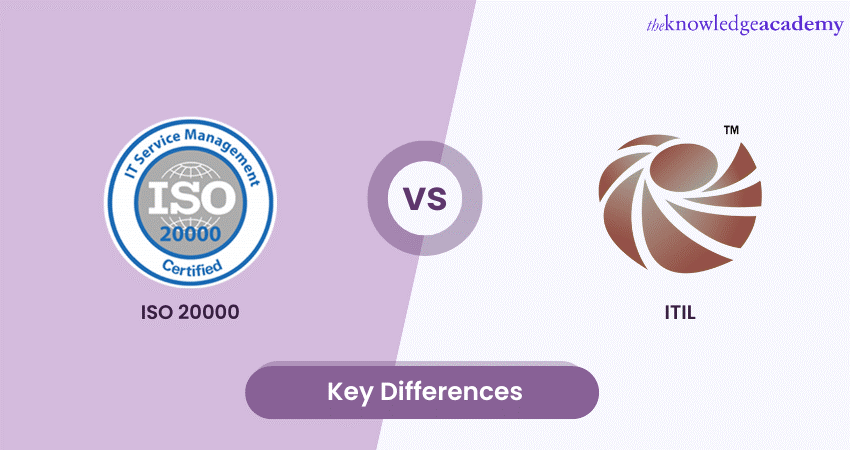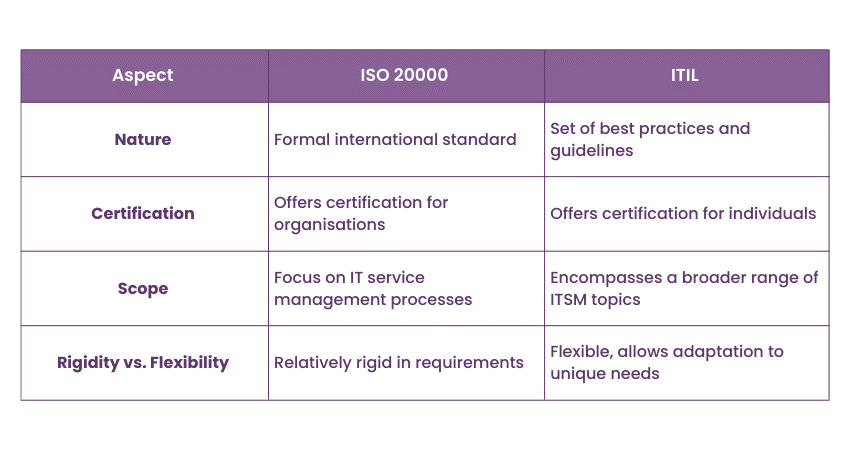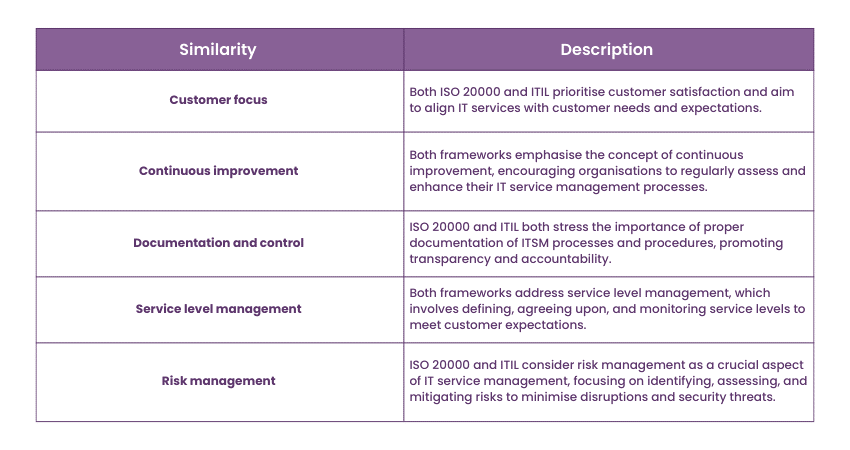We may not have the course you’re looking for. If you enquire or give us a call on +39 800580270 and speak to our training experts, we may still be able to help with your training requirements.
We ensure quality, budget-alignment, and timely delivery by our expert instructors.

In IT service management (ITSM), several frameworks and standards are designed to help organisations deliver effective and efficient IT services. Two of the most prominent and widely adopted methodologies are ISO 20000 and ITIL (Information Technology Infrastructure Library). These ITIL Frameworks are crucial in enhancing IT service quality and aligning IT with business objectives. In this blog post, we will understand the key differences and similarities between ISO 20000 vs ITIL to help you better understand how they can benefit your organisation.
Table of Contents
1) Introduction to ISO 20000 and ITIL
2) Key differences between ISO 20000 and ITIL
a) Nature
b) Certification
c) Introduction to ISO 20000 and ITIL cope
d) Rigidity vs flexibility
3) Key similarities between ISO 20000 and ITIL
a)Customer focus
b) Continuous improvement
c) Documentation and documentation control
d) Service level management
e) Risk management
4) Conclusion
Introduction to ISO 20000 and ITIL
ISO 20000
ISO 20000, officially known as ISO/IEC 20000-1, is an international standard for IT service management. It provides a comprehensive framework that outlines best practices and requirements for the effective management of IT services. ISO 20000 focuses on improving the quality of IT service delivery, enhancing customer satisfaction, and ensuring continuous service improvement, as highlighted in the ISO 20000 Implementation Guide.
Information Technology Infrastructure Library (ITIL)
ITIL, on the other hand, is a set of practices and guidelines for ITSM that originated in the United Kingdom. ITIL is not a standard like ISO 20000 but rather a collection of best practices and processes designed to help organisations align their IT services with business needs. ITIL covers various aspects of IT service management, including service strategy, design, transition, operation, and continual service improvement.

Key differences between ISO 20000 and ITIL

Let's look at a few key differences between the two standards based on the following criteria:
Nature
ISO 20000, formally known as ISO/IEC 20000-1, is an international standard for IT service management (ITSM). It is a formal and structured framework with specific requirements that organisations must adhere to in order to achieve certification. ISO 20000 outlines a set of predefined processes and criteria that focus on enhancing the quality of IT service delivery and ensuring continuous improvement. This standard is highly methodical and aims to establish a consistent approach to ITSM practices across organisations. It is recognised globally and provides a clear path for organisations to demonstrate their commitment to IT service excellence.
In contrast, ITIL is not a formal standard but rather a collection of best practices and guidelines for IT service management. ITIL offers a flexible and adaptable approach, allowing organisations to tailor their practices to meet their specific needs. It does not provide certification for organisations but offers certification for individuals at various levels. This flexibility is a defining characteristic of ITIL, making it suitable for organisations with diverse structures and requirements. It is more of a framework of recommendations and practices that organisations can choose to implement in a way that suits their unique circumstances.
Ready to earn your ITIL Foundation certification? Download the ITIL® Foundation Certification Guide now and get expert tips for success.
Certification
One of the key differences between ISO 20000 and ITIL lies in their approach to certification. While both frameworks are invaluable for enhancing IT service management (ITSM), they have distinct certification processes and objectives.
ISO 20000 Certification
ISO 20000 offers a formal certification process for organisations. To achieve ISO 20000 Certification, an organisation must demonstrate compliance with the standard's specific requirements for IT service management. This process involves rigorous assessments, audits, and documentation to ensure that the organisation's ITSM practices align with ISO 20000 standards.
The primary goal of ISO 20000 Certification is to validate an organisation's commitment to ITSM best practices and its ability to deliver high-quality IT services. ISO 20000 Certification is a formal recognition that the organisation's IT services meet international standards, which can enhance its credibility and competitiveness in the market.
ITIL certification
In contrast, ITIL does not offer certification for organisations. Instead, ITIL provides certification for individuals at various levels, such as ITIL Foundation, Practitioner, and Expert. These certifications are meant to validate an individual's knowledge and expertise in ITSM best practices based on the ITIL framework, with ITIL Certification Renewal ensuring their skills remain up to date.
ITIL certification focuses on building the skills and competencies of IT professionals, enabling them to apply ITIL principles effectively within their organisations. While ITIL certifications are valuable for personal and professional development, they do not imply organisational certification or compliance with specific standards. Exploring the ITIL Certification Path can help individuals understand the progressive levels of ITIL expertise and how they align with career goals.
Unlock your career potential with ISO 20000 Internal Auditor certification and lead the way in IT service excellence.
Focus
ISO 20000 is a formal international standard dedicated to IT service management. Its scope primarily revolves around IT service delivery and the quality of IT services. ISO 20000 outlines a structured framework that encompasses processes like incident management, problem resolution, change management, and service level management. It focuses on ensuring that IT services are delivered efficiently, effectively, and in alignment with customer expectations. The standard places particular emphasis on the operational aspects of ITSM.
In contrast, ITIL boasts a broader scope that encompasses the entire lifecycle of IT services. It comprises five core publications, each addressing a different stage: service strategy, service design, service transition, service operation, and continual service improvement. ITIL goes beyond operational aspects and dives into strategic planning, service design principles, and the continual enhancement of IT services. It provides a comprehensive approach to ITSM, offering guidelines for strategic decision-making, service design and transition, daily operations, and ongoing service improvement.
Rigidity vs flexibility
ISO 20000, as an international standard, tends to be relatively rigid in its requirements. It outlines specific criteria and processes that organisations must adhere to in order to achieve certification. While this rigidity can be beneficial in ensuring a consistent and structured approach to IT service management, it may not be suitable for organisations with unique needs or those that require a more adaptable framework.
ITIL, on the other hand, offers a more flexible approach. It provides a set of best practices and guidelines that organisations can adapt and customise to align with their specific requirements. This flexibility allows organisations to tailor their IT service management processes to suit their unique business goals, industry regulations, and existing practices.
Key similarities between ISO 20000 and ITIL

Customer focus
One key similarity between ISO 20000 and ITIL is their unwavering customer focus. Both frameworks prioritise aligning IT services with the needs and expectations of customers. They emphasise the importance of delivering high-quality services that satisfy end-users. ISO 20000 and ITIL recognise that customer satisfaction is at the core of successful IT service management. By placing customers at the forefront of their principles and practices, these frameworks aim to enhance service quality, foster positive client relationships, and ultimately contribute to the overall success of an organisation's IT service delivery.
Continuous improvement
One key similarity between ISO 20000 and ITIL is their shared emphasis on continuous improvement. Both frameworks recognise the importance of regularly assessing and enhancing IT service management practices. They promote a culture of ongoing refinement, encouraging organisations to adapt to changing business needs, technological advancements, and customer expectations. Continuous improvement fosters efficiency, effectiveness, and the delivery of high-quality IT services, aligning them with the evolving demands of the business landscape. This common focus on perpetual enhancement underscores their commitment to staying relevant and responsive in the dynamic field of IT service management.
Documentation and documentation control
One key similarity between ISO 20000 and ITIL is their emphasis on documentation and documentation control. Both frameworks recognise the critical role of thorough documentation in effective IT service management. They stress the importance of creating, maintaining, and controlling documentation for various ITSM processes and procedures. This documentation provides transparency, consistency, and a clear reference point for IT teams, ensuring that everyone understands their roles and responsibilities. Whether it's documenting service levels, incident management procedures, or change management processes, ISO 20000 and ITIL share a common commitment to robust documentation practices, which contribute to efficient and well-structured IT service delivery.
Service level management
One key similarity between ISO 20000 and ITIL is their emphasis on service level management. Both frameworks recognise the importance of defining, agreeing upon, and monitoring service levels to ensure that IT services meet customer expectations.
In ISO 20000, service level management is a crucial component of the standard, focusing on establishing clear Service Level Agreements (SLAs), monitoring performance against these agreements, and continually improving service delivery to maintain or exceed the agreed-upon service levels.
Similarly, ITIL dedicates a significant portion of its guidance to service level management, providing best practices for defining, negotiating, and managing service level agreements to enhance customer satisfaction and align IT services with business needs.
Risk management
One key similarity between ISO 20000 and ITIL is their shared emphasis on risk management within the realm of IT service management (ITSM). Both frameworks recognise the importance of identifying, assessing, and mitigating risks to ensure the reliability and security of IT services. They advocate for a proactive approach in recognising potential disruptions or security threats, allowing organisations to implement preventive measures and contingency plans. By integrating robust risk management practices, ISO 20000 and ITIL help businesses safeguard their IT operations, minimise downtime, and ensure the continuity of service delivery, ultimately enhancing the quality and reliability of IT services.
Download the ISO 20000 PDF and improve your IT service management!
Conclusion
When it comes to IT service management, the choice between ISO 20000 vs ITIL ultimately hinges on your organisation's specific needs. ISO 20000 can offer numerous Benefits of ISO 20000 such as a structured, certification-oriented approach, while ITIL provides flexibility and comprehensive guidance. Carefully evaluate your goals and resources to select the right path for achieving IT service excellence.
Upgrade your IT service management skills with ISO 20000 Training and excel in delivering high-quality IT services.
Upcoming IT Service Management Resources Batches & Dates
Date
 ISO 20000 Foundation
ISO 20000 Foundation
Mon 3rd Mar 2025
Mon 2nd Jun 2025
Mon 1st Sep 2025
Mon 17th Nov 2025






 Top Rated Course
Top Rated Course


 If you wish to make any changes to your course, please
If you wish to make any changes to your course, please


